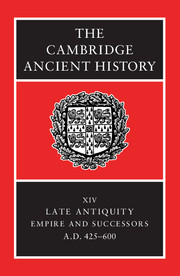Book contents
- Frontmatter
- PART I CHRONOLOGICAL OVERVIEW
- PART II GOVERNMENT AND INSTITUTIONS
- PART III EAST AND WEST: ECONOMY AND SOCIETY
- 12 Land, labour and settlement
- 13 Specialized production and exchange
- 14 The family in the late Roman world
- 15 Family and friendship in the west
- 16 State, lordship and community in the west (c. A.D. 400–600)
- 17 Armies and society in the later Roman world
- PART IV THE PROVINCES AND THE NON-ROMAN WORLD
- PART V RELIGION AND CULTURE
- Conclusion
- Chronological Table
- BIBLIOGRAPHY
- Index
- References
13 - Specialized production and exchange
from PART III - EAST AND WEST: ECONOMY AND SOCIETY
Published online by Cambridge University Press: 28 March 2008
- Frontmatter
- PART I CHRONOLOGICAL OVERVIEW
- PART II GOVERNMENT AND INSTITUTIONS
- PART III EAST AND WEST: ECONOMY AND SOCIETY
- 12 Land, labour and settlement
- 13 Specialized production and exchange
- 14 The family in the late Roman world
- 15 Family and friendship in the west
- 16 State, lordship and community in the west (c. A.D. 400–600)
- 17 Armies and society in the later Roman world
- PART IV THE PROVINCES AND THE NON-ROMAN WORLD
- PART V RELIGION AND CULTURE
- Conclusion
- Chronological Table
- BIBLIOGRAPHY
- Index
- References
Summary
DIFFCULTIES AND EVIDENCE
Writing about complexity within the economy of the fifth to the seventh century will never be straightforward, partly because there has been so much debate about the nature of the ‘classical’ Roman economy that preceded it. Was the ‘Roman economy’ really a series of local economies, linked into a broader structure only by the demands of the state and by some limited trade in luxury products? Or was it a unified system in which even quite basic goods were produced by specialists, and traded by merchants across long distances? In examining economic activity in the late Roman and post-Roman period, we are inevitably measuring it against the classical economy that preceded it; but the measuring-stick itself is constantly being altered.
As with evidence for the exploitation of the land examined in the last chapter, much of our information on economic specialization now derives from archaeology. However, the written record can also produce isolated but very valuable nuggets of information. For example, just before our period, Gregory of Nazianzus happens to tell us, in a poem on the events of his own life, that one of his enemies in Constantinople in 379/80 was a priest who had come to the city from Thasos, with money supplied by his church in order to buy ‘Proconnesian slabs’ (prokonesias plachas). These must have been slabs for a chancel-screen in the marble of the island of Proconnesos (very close to Constantinople), of a type which was widely diffused in late antiquity (see Fig. 15,p. 359 below).
- Type
- Chapter
- Information
- The Cambridge Ancient History , pp. 346 - 391Publisher: Cambridge University PressPrint publication year: 2001
References
- 29
- Cited by

